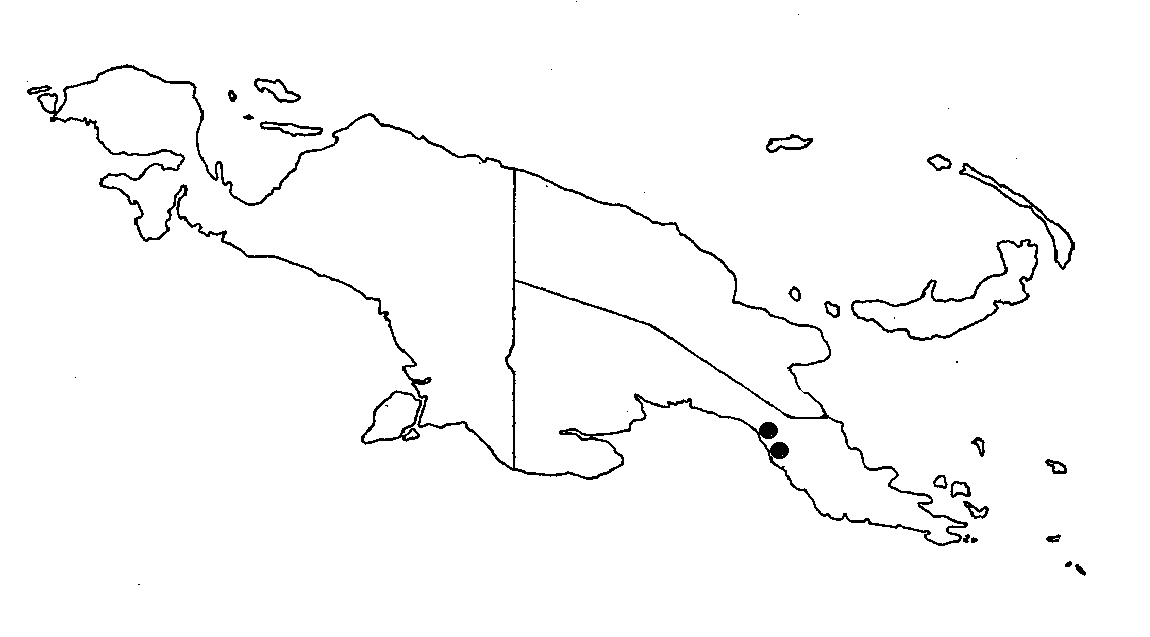
Distribution Map

Description (Barlow 1992)
Ungula tetrafiora Barlow, Proc. Roy. Soc. Qd. 75 (1964) 16. - Amyema tetra flora (Barlow) Barlow, Austral. J. Bot. 22 (1974) 595. - Type: van Duuren s.n. (holo BRI 039104), New Guinea, Ukua Estate via Kairuku, ixJ962.
For description see Barlow, Austral. J. Bot.
22 (1974) 595. Amyema tetra flora can be identified locally
by its combination of large, opposite, bifacial, very shortly
petiolate leaves, unusual umbels of tetrads with all flowers sessile,
and shortly gamopetalous corolla. The flower colour is described
as light mauve.
Amyema tetra flora is known only from the Kairuku Subdistrict
of Papua New Guinea (fig. 15; 3 collections seen), at low elevations
up to 50 m. Habitat details and hosts are unknown. The species
is very distinctive in its shortly gamopetalous corollas and unusual
floral tetrads, and with the related A. brassii comprises
a small satellite of the main field of variation in the genus.
It can be distinguished from A. brassii by its shoner corolla
tube and tetrads with all flowers sessile.
Production of flowers in tetrads rather than triads occurs in
Amyema in a few apparently distantly related species or
species groups, and the condition has probably arisen independently
several times. It is presumably established as an inflorescence
elaboration resulting from modification of the basic dichasial
uniflorescence of the genus.
Description (Barlow 1974)
Amyema tetraflorum (Barlow) Barlow, comb. nov.
Ungula tetrafiora Barlow, Proc. Roy. Soc. Qd. 75: 16, illus. Fig. 1, c-e (1964). Type-New Guinea, Ukua Estate via Kairuku, van Duuren sn., Sept. 1962 (BRI 039104, holotype; BRIU 1493).
Glabrous except for the inflorescence and flowers sparsely tomentose. Stems smooth, terete, regularly and more or less dichotomously branched. Leaves opposite; petiole terete, 2-4 mm long; lamina broad lanceolate to ovate-lanceolate, 17-25 by 7-12 cm, rounded to slightly cordate at the base, shining above, dull below, acuminate and acute at the apex; venation distinctly pennate with the lateral veins incurved near the margin. Inflorescences borne at the nodes and on the runners; peduncle 2-4 mm long, 1.5-2 mm wide, slightly wider at the apex; rays 4 or 6, spreading, 1-2.5 mm long, slightly thinner than the peduncle; flowers in tetrads with all flowers sessile and orientated with one flower towards the centre of the inflorescence, two lateral and one towards the outside; bracts erect, the adaxial one narrow, 25-35 mm long, attenuate and acute, the other three broad lanceolate, 2-3 mm long, acuminate and acute, longer than the calyx. Calyx compressed-angular, 1.5-2 mm long; limb erect, 6-toothed, 0.7 mm long. Corolla in the mature bud slender, slightly clavate, 26-32 mm long; petals in the open flower 6, coherent in the lower 4-5 mm, each with a deflexed spur inside 1 mm above the base. Anthers narrow, c. 3 mm long; free parts of the filaments c. 5 mm long. Fruit not seen.
Occurrence. Eastern New Guinea, near Kairuku (Fig. 6), at low altitudes.
Specimens Examined. EASTERN NEW GUINEA: Akaitu R. near Maipa Village, Kairuku Subdist., 50 m alt., Darbyshire 887, 5.ix.1962 (CANB; L); Ukua Estate via Kairuku, van Duaren, Jan. 1963 (BRI).
See note under Amyema brassii.
Illustrations
Photographs
Amyema tetraflora
updated 18 January 2007